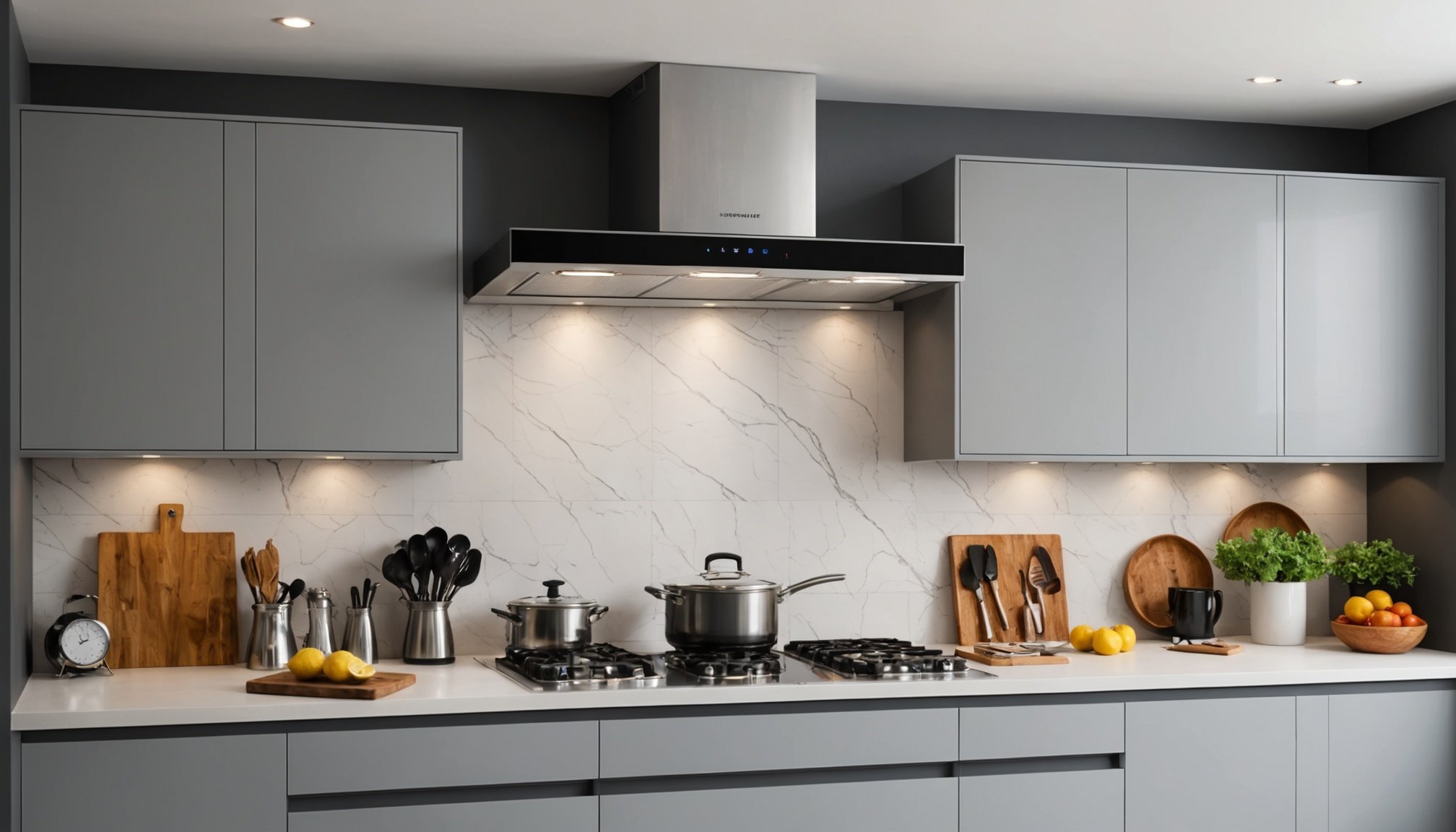Overview of Kitchen Ventilation Systems
Kitchen ventilation systems are integral to maintaining a safe and comfortable cooking environment, as they efficiently dispose of pollutants, smoke, and excess heat. These systems perform the crucial role of improving air quality and ensuring health and safety in the kitchen.
There are several types of ventilation systems commonly used in the UK. The most prevalent option is the ducted range hood, which extracts air outside through ductwork. Non-ducted or recirculating range hoods, which filter and circulate air back into the kitchen, offer flexibility where external venting isn’t feasible. Another choice is the downdraft ventilation system, which pulls air downwards through vents installed behind or beside the cooktop.
Topic to read : Revamping Your Classic UK Kitchen: Top Strategies for Enhanced Energy Efficiency
The importance of ventilation cannot be overstated from a safety perspective. Efficient ventilation not only reduces the risk of respiratory problems by removing harmful pollutants but also prevents the build-up of grease and flammable vapours, minimizing fire hazards. Ensuring the installation of the right ventilation in your kitchen thus combines functionality with safety, safeguarding both your health and property. Therefore, understanding these systems and choosing appropriately can significantly enhance your kitchen’s ambiance and usability.
Selecting the Right Kitchen Ventilation System
Choosing the ideal kitchen ventilation systems involves understanding several crucial factors to ensure they align with your needs. Begin by considering the size, type, and airflow capacity of the ventilation system. It is vital to match the chosen system’s capacity with your kitchen’s dimensions to achieve efficient pollutant extraction.
Have you seen this : The Ultimate Guide to Choosing the Perfect Cast Iron Skillet for Your UK Kitchen
Another key aspect is compliance with local building regulations and standards in the UK. These standards ensure your system operates safely and effectively, safeguarding against fire hazards and health risks. Always review these legal requirements before installation.
Aesthetic preferences also play a significant role. It is essential to balance these with functional requirements, as a system that complements your kitchen’s design enhances the overall ambiance without compromising on performance.
When selecting ventilation systems, it is worth considering the existing ductwork, especially in renovations, to determine the best type of system. Whether you prefer a ducted or non-ducted system will depend on your ability to install external ducting. By prioritising these factors, you can choose a system that not only fulfills ventilation requirements effectively but also seamlessly integrates with your kitchen’s layout and decor.
Step-by-Step Installation Guide
Installing a kitchen ventilation system can seem daunting, but a structured approach simplifies the process. This guide covers key steps for DIY installation.
Tools and Materials Needed
To begin, gather essential tools: a drill, screwdriver, saw, and measuring tape. Common materials include ductwork, mounting brackets, screws, and an appropriate power source for the ventilation system. Ensuring you have everything ready before starting will streamline the installation.
Preparing the Installation Area
Before installing, clear the area and confirm measurements are accurate. Check wall or ceiling strength, as these will support your chosen system. Ensuring your kitchen is ready for the changes promised by the new system is crucial.
Installing the Ventilation System
Follow these core steps for effective installation:
- Securely attach mounting brackets at marked points.
- Install ductwork according to the manufacturer’s instructions, ensuring tight seals to prevent air leaks.
- Connect electrical wiring carefully, adhering to safety standards.
- Test the system post-installation to verify proper operation.
Each type of ventilation system might have specific instructions, so consult the manual. Proper installation not only optimises performance but also prolongs the lifespan of your kitchen ventilation system.
Optimizing Kitchen Ventilation Performance
Enhancing the performance of kitchen ventilation systems is essential for maintaining an effective cooking environment. Improving airflow management can significantly boost system efficiency. Positioning the ventilation unit directly above the cooking area is crucial, as this maximises the capture of smoke and steam. Additionally, ensure there’s a clear path for air to flow through the ductwork with minimal obstructions.
Proper ducting plays a vital role in optimizing ventilation performance. Utilize smooth, straight ducting to reduce air resistance. Flex ducts may be necessary in some installations, but minimize their length to avoid airflow reduction. The shorter and straighter the duct, the better the air movement.
Another key tip is to regularly clean and maintain your system to prevent blockages that hinder airflow. Filters need frequent inspection and cleaning as grease accumulation affects performance.
Furthermore, consider using a window or door slightly ajar to enhance natural cross-ventilation. This simple step helps in supplementing the mechanical system, promoting better airflow.
By focusing on these performance tips and placement strategies, you can ensure your kitchen ventilation system functions at its best, providing a healthier and more comfortable cooking environment.
Maintenance and Troubleshooting
Maintaining your kitchen ventilation systems ensures they operate efficiently and prolong their lifespan. Regular maintenance is paramount to prevent common issues that can compromise performance. Begin by routinely inspecting and cleaning filters, as grease build-up can significantly reduce airflow and efficiency. It’s advisable to replace charcoal filters in non-ducted systems every few months for optimal performance.
Common problems such as noisy operation or weak suction are often due to blockages in the ducting. Ensuring the ductwork is clear and free from obstructions can resolve these issues. If unusual odours persist despite cleaning, it might indicate the need for filter replacement or a thorough cleaning of internal parts.
Recognize signs that warrant professional intervention. Persistent performance issues, strange noises, or inefficient smoke and odour removal may indicate underlying mechanical or electrical faults. Rather than turning a blind eye to these symptoms, engaging a professional can prevent further damage and costly repairs.
Troubleshooting should begin with the assessment of routine maintenance tasks and progress to more technical evaluations if issues persist. Keeping a vigilant eye on your ventilation system’s performance is crucial to maintaining a healthy and safe cooking environment.
Cost Considerations
When investing in kitchen ventilation systems, understanding the potential costs is essential for effective budgeting. Initial expenses can vary significantly based on the type of ventilation system selected. Ducted systems generally incur higher costs due to the need for ductwork installation, often amounting to several hundred pounds. On the other hand, non-ducted systems are more budget-friendly, as they circulate air internally and require less extensive setup.
Budgeting Tips
- Installation Expenses: Consider the cost of professional installation, which might be essential for ducted systems.
- Long-term Efficiency: Opt for systems with energy-efficient features. Although the upfront cost may be higher, savings on energy bills over time can be substantial.
- Maintenance Costs: Factor in the cost of regular maintenance and filter replacements, vital for keeping the system in top working condition.
Investing in a robust ventilation system can also yield long-term savings by enhancing kitchen efficiency and potentially increasing property value. Careful budgeting not only ensures a wise purchase but also contributes to the sustainability of your kitchen environment.
Recommended Products and Brands
Selecting the right kitchen ventilation systems involves considering high-quality products and reliable brands. When exploring the UK market, some brands consistently stand out for their performance and reliability.
Top Choices in the UK Market
-
Bosch: Known for innovative technology and sleek designs, Bosch offers efficient range hoods that cater to modern kitchen aesthetics. Their systems are robust, favouring both ducted and non-ducted models, which integrate seamlessly with various kitchen styles.
-
Neff: Renowned for their advanced features, Neff provides a range of hoods that combine efficiency with style. Their systems often feature quiet operation and energy-saving options, making them an excellent choice for those prioritising energy efficiency.
-
AEG: Offering a variety of ventilation solutions, AEG is celebrated for its durable and powerful extraction capabilities. Their models emphasise ease of use and are designed to meet diverse cooking requirements.
When choosing a ventilation system, it is crucial to evaluate each brand’s offerings relative to your specific needs, such as kitchen size, cooking habits, and design preferences. Opting for well-regarded brands ensures quality and performance, contributing to a healthier and more functional cooking environment.
Addressing Common Challenges
Installing kitchen ventilation systems might seem straightforward, but several challenges can arise, especially in older homes or non-standard kitchen layouts. One typical issue is the lack of adequate space for ducting, which can limit the type of system that can be installed. When faced with limited space, a recirculating system might be more feasible, as these don’t require external ducting.
Another common challenge involves ensuring the system meets local building regulations. It’s crucial to verify that all components—like duct materials and electrical connections—adhere to these standards to ensure safety and compliance.
In non-standard layouts, aligning the ventilation system with the cooktop might be difficult. Using flexible ducting can help connect equipment that isn’t directly aligned, though it shouldn’t compromise airflow efficiency.
When these challenges become too complex, seeking professional help can be invaluable. Experts can provide tailored solutions, ensuring your kitchen remains both functional and compliant. Moreover, they can identify potential issues early, saving you time and cost in the long run.
By considering these challenges and adopting practical solutions, you can ensure a smooth installation and optimal performance of your kitchen ventilation system.

